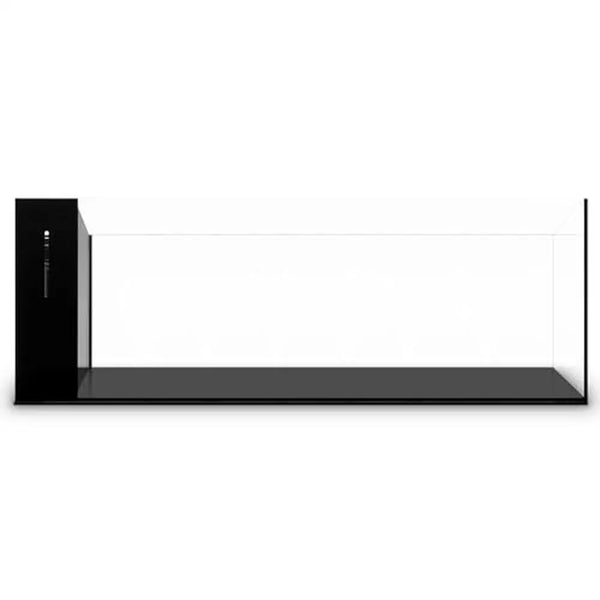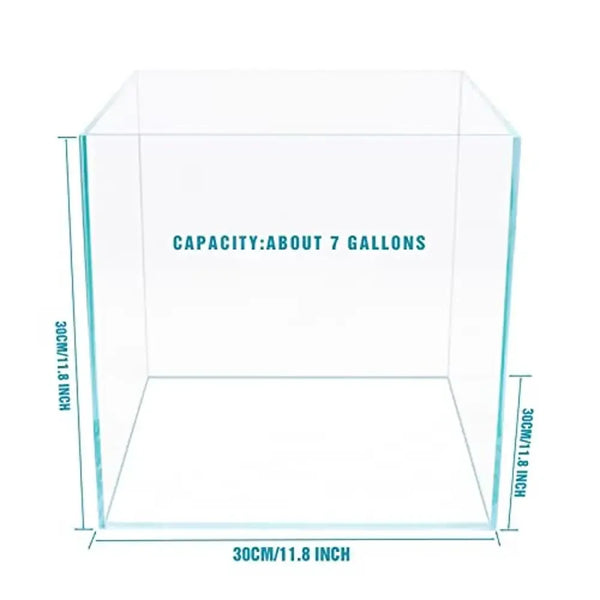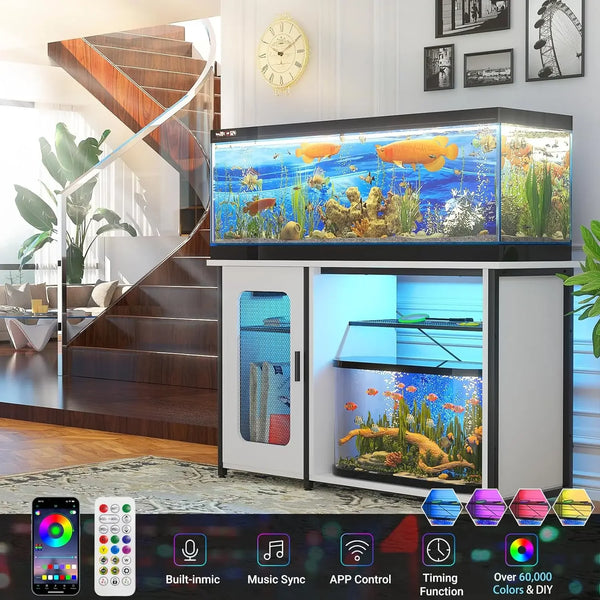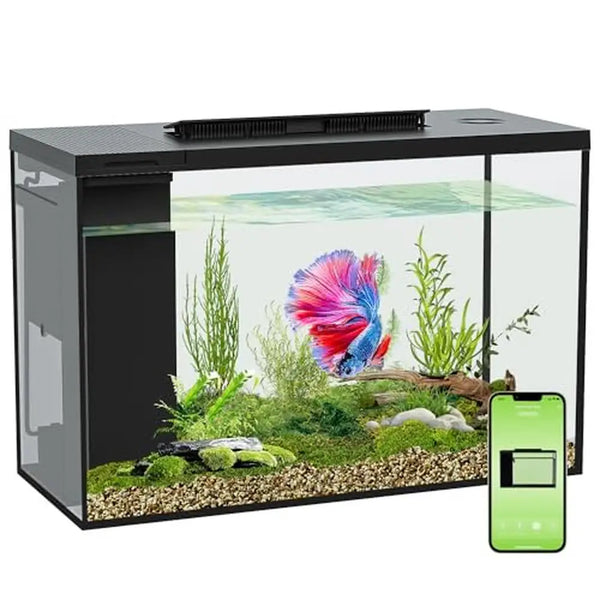1. What is an Eco-Water Grass Tank?
An eco-water grass tank, also known as a planted aquarium, is an aquatic ecosystem that aims to replicate a natural environment. It features live aquatic plants, fish, and various other aquatic organisms, working together to form a balanced and self-sustaining habitat. In contrast to conventional fish tanks that often depend on artificial elements and chemical treatments, eco-water grass tanks operate through natural processes. This setup is rooted in aquascaping, a widely embraced technique that emphasizes the importance of live plants in creating a thriving aquatic habitat.
2. Benefits of an Eco-Water Grass Tank

Eco-friendliness: An eco-water grass tank, featuring live plants, absorbs carbon dioxide and produces oxygen, which is beneficial for the fish and other inhabitants. It creates a small ecosystem that relies less on artificial materials and filtration systems.
Aesthetic Appeal: These tanks are visually striking. The lush green plants, along with the aquatic life, enhance the natural beauty of any space.
Better Fish Health: The natural environment within the tank can alleviate stress for fish, encourage breeding, and contribute to longer, healthier lives. Additionally, the plants provide hiding spots, helping fish feel more secure.
Low Maintenance: Although setting up a stable ecosystem may require some initial effort, once established, an eco-water grass tank typically demands less upkeep than traditional tanks.
Mental and Emotional Benefits: Engaging in aquascaping and maintaining an eco-water grass tank can be a calming and therapeutic experience, helping to reduce stress and strengthen your connection to nature.
3. Planning Your Eco-Water Grass Tank Setup

Setting up an eco-water grass tank requires careful planning, especially if you want to create a balanced ecosystem. Here are some key points to consider:
Size and Type of Tank: Your selection should be based on the available space, the types of plants and fish you wish to keep, and your budget.
Filtration and Lighting: Opt for systems that promote plant growth while maintaining the natural cycles.
Plants and Animals: Choose plants, fish, and invertebrates that can live together peacefully.
Design and Layout: Develop an aquascape design that is both functional for the tank's inhabitants and visually attractive.
4. Choosing the Right Tank and Equipment

Tank Size: A 20-gallon tank is a great choice for beginners, as it provides ample space for a variety of plants and fish while helping to stabilize the ecosystem with sufficient water volume. Larger tanks offer more diversity and make it easier to manage water parameters.
Filter: Although eco-water grass tanks depend on plants for water purification, having a filter is still important for maintaining water quality. A gentle filter that won’t disturb the plants or substrate is the best option. Many aquarists opt for sponge filters or external canister filters because they are both gentle and effective.
Lighting: Adequate lighting is essential. Most water grass species thrive with moderate to high light for photosynthesis, usually needing around 8-12 hours of light each day. LED lights are favored for their efficiency, customizable settings, and ability to replicate natural sunlight.
CO2 System: To promote lush plant growth, particularly in tanks with more demanding species, a CO2 injection system can be very helpful. This setup enhances plant growth and contributes to creating oxygen-rich water.
5. Water Grass Varieties for Aquascaping

Selecting the right water grass for your aquarium is crucial for establishing a vibrant, green underwater landscape. Here are some popular choices:
Java Moss: This easy-to-cultivate moss creates a thick carpet and thrives in low light, making it perfect for beginners.
Dwarf Hairgrass: Recognized for its grassy look, it forms a natural carpet but requires moderate lighting and a nutrient-rich substrate.
Amazon Sword: Featuring broad, green leaves, this plant adds height and visual interest. It’s resilient and flourishes in low light conditions.
Anubias Nana: A low-maintenance option that adapts well to various environments. Its wide leaves offer excellent hiding spots for fish.
Rotala Rotundifolia: A beautiful plant that showcases red and green leaves, needing moderate to high lighting to thrive.
Each plant has unique needs regarding lighting, CO2, and nutrients, so it's best to combine plants with similar requirements for a balanced aquarium.
6. Substrate Choices for Water Grass Tanks

Selecting the appropriate substrate is crucial as it serves as the base for your plants and influences nutrient levels.
Nutrient-Rich Soil: Specialized aquatic plant soils, like ADA Aqua Soil, are formulated to release nutrients effectively and promote healthy plant growth.
Sand and Gravel: These materials can be used as a top layer, offering a stable base for roots while facilitating water movement through the substrate.
Layered Substrate: Many aquarists opt for a combination of nutrient-rich soil at the bottom and a layer of sand or gravel on top. This arrangement supplies nutrients to the plants while reducing the amount of debris released into the water.
Make sure the substrate is at least 1-2 inches deep to support root establishment.
7. Setting Up the Ecosystem: Plants, Fish, and Invertebrates

Creating a balanced ecosystem requires selecting compatible plants, fish, and invertebrates:
Plants: Start by placing larger plants in the back, shorter grasses in the front, and mosses on rocks or driftwood.
Fish: Choose species that won’t disturb the plants or substrate, such as:
Tetras: Small and peaceful, neon tetras bring vibrant color to the tank.
Rasboras: These hardy and calm fish thrive in planted environments.
Otocinclus Catfish: Renowned for their algae-eating habits, they contribute to plant health.
Invertebrates: Some invertebrates can help keep the tank clean without harming the plants:
Amano Shrimp: Excellent at eating algae and detritus.
Nerite Snails: Effective algae eaters that are gentle on plants.
Cherry Shrimp: These hardy and attractive shrimp also assist in maintaining a clean tank.
8. Maintaining the Eco-Water Grass Tank

To keep an eco-water grass tank in good condition, focus on the following maintenance tasks:
Water Changes: Replace 10-20% of the water each week to ensure optimal water quality.
Fertilization: Use liquid fertilizers and root tabs to provide essential nutrients for the plants.
Trimming and Pruning: Regularly trim plants to avoid overcrowding and promote healthy growth.
Algae Control: Keep an eye on algae levels; introducing algae-eating fish or shrimp can help manage it.
Monitoring Water Parameters: Frequently check pH, ammonia, nitrite, and nitrate levels to maintain a balanced environment.
9. Common Challenges and Solutions
Algae Blooms: These are often seen in newly established tanks. You can control algae by introducing algae-eating species, minimizing lighting, and performing regular water changes.
Plant Growth Issues: If your plants are stunted or turning yellow, it may be a sign of nutrient deficiencies. Modifying your fertilizers or CO2 levels can make a difference.
Fish Illness: To prevent disease, always quarantine new fish before adding them to your tank. Keeping water conditions stable is crucial for reducing stress on your fish.
Poor Water Quality: If the water appears cloudy or murky, it could be due to problems with the substrate, filtration, or waste accumulation. Regular maintenance and effective filtration are key to resolving these issues.
10. Last Words
Setting up an eco-water grass tank requires dedication, particularly during the initial setup and cycling phases. However, once it's up and running, it transforms into a low-maintenance, self-sustaining ecosystem. The true charm of the tank lies in its natural beauty and the balanced interactions among the plants, fish, and other organisms.
Explore more at PlantedPro, your go-to source for handcrafted terrariums and aquascaping supplies.
Tell us - Was this article helpful? Please comment your thoughts below!
If you have any questions regarding this article, please DM us on Instagram or Facebook (@plantedpro), or email us directly at hi@plantedpro.com so we can assist you - questions cannot be replied to here.


![Green Mountain - Microlandscape [Including Internal Plants + Decoration]](http://plantedpro.com/cdn/shop/articles/GridArt_20241117_202046513.jpg?crop=center&height=90&v=1754909977&width=90)








































![Pavilions Moss Microecological Landscape [Including Internal Plants + Decoration]](http://plantedpro.com/cdn/shop/files/Pavilion_Moss_Planted_Pro.png?crop=center&height=600&v=1745762480&width=600)
![Tree of Life - Moss Microlandscape [Including Internal Plants + Decoration]](http://plantedpro.com/cdn/shop/files/11_900x_e50e9d85-02a0-4773-944e-d2cd82674841.jpg?crop=center&height=600&v=1730216177&width=600)
![Green Hills - Moss Microlandscape [Including Internal Plants + Decoration]](http://plantedpro.com/cdn/shop/files/20240910013738_1080x_2859d709-be4d-4f60-a2ff-198aafae9f77.jpg?crop=center&height=600&v=1730215869&width=600)
Leave a Comment